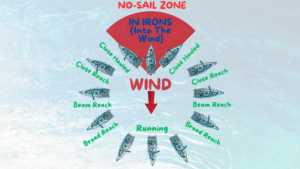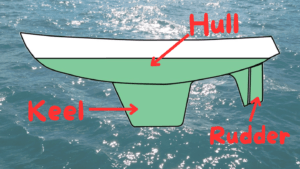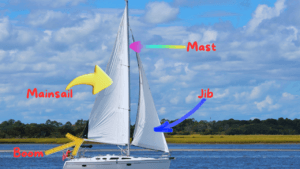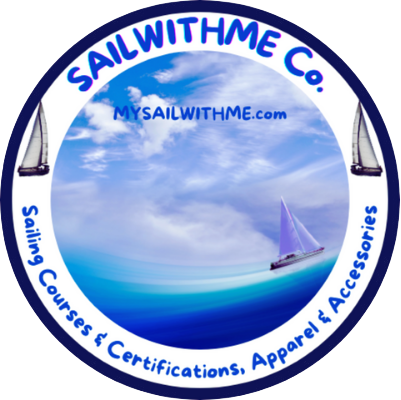
Sailing is a timeless pursuit that blends adventure, skill, and a deep connection with nature. Starting out in sailing can feel overwhelming with all the new words and ideas. But learning these terms is key to staying safe and communicating well while you’re on the water. Understanding the basic terminology in sailing is a foundation for clear communication and safety aboard a vessel. I’m going to introduce you to some essential terms every sailor should have in their quiver.
We’ll start at the very front of the boat, known as the ‘bow‘, and the back, or the ‘stern‘. These words help everyone onboard know which direction things are in relation to the boat’s orientation. Now, ‘port‘ and ‘starboard‘ are the left and right sides of the boat, respectively, but these are determined when facing the bow, a constant that prevents confusion no matter which way you’re facing.
Next is about ‘leeward‘ and ‘windward‘, terms that indicate the direction relative to the wind. Leeward means the direction downwind, while windward is the opposing direction from which the wind is coming. And when we talk about ‘bearing‘, we’re describing the direction to an object, and ‘heading‘ is the direction the vessel is currently moving in.
Now, let’s get into some action! ‘Tacking‘ refers to turning the bow through the wind so that the wind changes from one side of the boat to the other. ‘Jibing‘, on the other hand, is when you turn the stern through the wind.
Heeling is when the boat leans to one side due to the wind’s pressure on the sails. It’s exciting but requires an understanding of balance and sail adjustment. Speaking of which, ‘trimming‘ is the process of adjusting the sails to maximize their efficiency with respect to the wind.
This is how the basic terms not only help sailors communicate but also navigate and maneuver. And it’s vital to acknowledge that as you progress, your vocabulary will too. As we move into the next section, I’ll cover how you can use more specific terms to refine your sailing strategies and enhance your experience on the water.
Navigating the Waves
Once you’ve got the basics down, it’s time to add more marinades to your sailor’s stew of words. This is crucial when you’re trying to navigate through choppy seas or communicate over the howl of the wind.
Let’s talk about speed and distance. You might think, ‘Why not use miles per hour?’ In open water, ‘Knots‘ rule the roost. One knot equals one nautical mile per hour, and it’s not the same as your car’s mile. A nautical mile is a unit of measurement used primarily in maritime contexts. It’s important for navigation because it is directly based on the Earth’s shape, making it a hair longer than the mile you’re used to on land. Grasping this will help you gauge how fast you’re traveling, and with the nautical mile being a global standard, it keeps sailors on the same page, no matter where they hail from. I invite you to check out this comprehensive article related to knots and nautical miles.

Now, steer your attention to the ‘Rudder‘ and ‘Keel‘. These are more than parts of a boat; they’re essential in controlling your course. The rudder, attached to the back of the boat, swings left or right, guiding you through the waters, while the keel, running along the bottom, keeps you stable and upright. Think of the keel as your boat’s balancing pole.
Every sailor needs to understand ‘Charts‘, ‘Tides’, and ‘Current‘. Reading nautical charts is like deciphering treasure maps, but instead of ‘X marks the spot’, you’re looking for buoys, depths, and coastlines. Tides, caused by the moon’s gravitational pull, can be friend or foe. High tide may help you clear an otherwise shallow passage, while low tide could leave you stuck. Currents, the river-like flow of water within seas and oceans, demand respect. They can speed you up, slow you down, or push you way off course. Success in sailing often hinges on reading these natural forces right.
Mastering the Craft: Advanced Sailing Terminology
If you’ve grasped the basics and intermediate terms in sailing, you’re ready for the advanced terminology that can truly elevate your sailing expertise. These terms aren’t just fancy jargon; they’re essential for handling complex situations and maneuvering your vessel with finesse during challenging conditions.
Let’s tackle some sophisticated maneuvers first. ‘Heave-to‘ is a technique used to stabilize the boat in strong winds. It’s a way to pause your journey, giving you time to rest or ride out a storm. A ‘broach‘ happens when a boat gets turned sideways, usually to the wind or waves, which can be dangerous. Making sure you know how to handle a ‘broach’ situation is critical for any sailor.
Gybing, also known as jibing, is a maneuver used to change course by turning the stern through the wind. Gybing requires precision and timing because it involves shifting the boom and sail from one side of the boat to the other. Get this wrong, and you risk injury or sail damage due to the forceful movement of the boom.
Now, understanding sail shapes and types plays a crucial role in capturing the wind efficiently. A ‘Genoa‘ is a large jib that overlaps the mainmast, designed for light to moderate winds, while a ‘Spinnaker‘ is a balloon-shaped sail for downwind sailing that can give you a significant speed advantage in the right conditions.

Your awareness and appreciation of weather patterns will inform many of your sailing decisions. Being ‘becalmed‘ means your sailboat is motionless due to lack of wind — a test of patience and an opportunity to practice your light wind sailing strategies. On the other hand, a ‘squall‘ is a sudden, sharp increase in wind speed that can catch you off guard. And a ‘gale‘? Well, that’s strong wind calling for high alert, often requiring you to reduce sail area to maintain control.
The Language of the Sea: Applying Sailing Terminology in Practice
Each of these elements affects how you’ll interact with your vessel and the sea, reinforcing the importance of knowledge and preparation in sailing. I’m here to help you see how these terms function in the dynamic environment of the sea. Imagine yourself at the helm, with the wind in your sails and a crew at your back. By knowing your luff from your leech, you can issue concise instructions that could be the difference between smooth sailing and a chaotic deck.
Now, let’s step into a scenario. You’re in a race, vying for the lead. You call out, ‘Prepare to gybe!’ Thanks to your crew’s training and understanding of this critical term, they move with precision, and the boat responds beautifully, gaining you an advantage.
Finally, remember that becoming fluent in the language of the sea is an ongoing journey. There are clubs, online forums, and hands-on experiences that offer a treasure trove of knowledge. Engage regularly, practice consistently, and soon you’ll navigate both conversations and currents with equal prowess. Happy Sailing!

